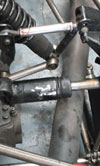The origins of the modern race car gearbox?
 Up until the end of the 1950s, when the front engined Grand Prix car predominated, it was not uncommon to find it’s transmission attached to the engine bell housing, in classic road car configuration, with the box itself almost always in-line, and often road car derived. But it was equally the norm to find the transmission in unit with the rear axle and differential, particularly in a thoroughbred racing design, in which case it was as common for it to be aligned transversally, as in-line.
Up until the end of the 1950s, when the front engined Grand Prix car predominated, it was not uncommon to find it’s transmission attached to the engine bell housing, in classic road car configuration, with the box itself almost always in-line, and often road car derived. But it was equally the norm to find the transmission in unit with the rear axle and differential, particularly in a thoroughbred racing design, in which case it was as common for it to be aligned transversally, as in-line.
When the mid-engined car began to take over in the late 1950s, the transmission naturally remained at the rear, in unit with the final drive, but now a conventional front-engined road car gearbox no longer provided a decent starting point. The early Coopers instead used a road car based Citroen transaxle adapted from the front-wheel drive Light 15, whilst other transaxles of the era were based around the rear-wheel drive Renault and VW gearboxes – the Hewland. In rotating them about the final drive axis to sit behind the engine, the gear cluster now stuck out behind the rear wheel centreline.
It so happened that the other early examples of mid-engined Formula cars produced by BRM and shortly afterwards by Lotus used transaxles that were derived directly from their existing front-engined Grand Prix cars, and in both of these cases these units were in-line. The BRM already had its gears behind the final drive, so that in the front-engined car the driver did not have to sit above them, whilst the Lotus had been designed initially for an offset driveline and laydown engine installation. As a result, the BRM unit was almost a straight fit, whilst the Lotus, with its gears in front of the differential needed extensive redesign work. In this perhaps conservative rework, the gear clusters ended up in the same position as on the BRM.
Thus in 1959, when Cooper customer Rob Walker commissioned his own transaxle for a BRM engined Cooper special, ex-Maserati engineer Valerio Colotti designed a unit that was also in-line, with gears behind the diff, and so, fortuitously when Walker switched to a Lotus 18 the following year, the Colotti ‘box became a retro fit for it, and many Lotii to follow. Along with its derivatives this gearbox would go on to become available to all .
A bespoke 5-speed in-line gearbox followed from Cooper – the C5S – in 1960, and so by the early 1960s there was a small cottage industry in the UK and in Italy where you could go to buy a race car transaxle. By force of circumstance all of these units were in-line, all with gears behind the differential, and this established a pattern that would hold up for the next 25 years.
The few exceptions tended to originate from a manufacturer racing programme, for no specialist Formula One constructor of the time had the resources, either financial or otherwise, to develop their own transmissions. Gradually the Hewland began to predominate, although for many years Lotus stayed faithful to the ZF company’s products, chosen to replace its own design and so again in-line, with gears behind the diff. BRM redesigned their own gearbox several times, always maintaining the basic layout, but as new constructors came along, they naturally turned to the proven and available product, which was the Hewland FG and DG series.
Along the way, the Honda companies first Grand Prix car, which employed a transverse engine, also employed a transverse gearbox – it was to all intents and purposes a scaled up motorcycle powertrain, whilst both Alfa Romeo and Porsche successfully employed in-line units with the gear cluster ahead of the differential on the sports racing cars. The Alfa unit appeared briefly in Formula One in 1972 in the back of a March, before disappearing again, and it was not until 1975, and the appearance of the transverse 5-speed unit in the Ferrari 312T, that the pattern was broken. For many more years the Ferrari would be alone in using this layout, and when Lotus decided, a few years later to redesign their 1950s gearbox for current Formula One use, they maintained the in-line layout, with overhung gear shafts.
This gearbox was sequential, and so we can see that about 30 years ago, the set of ingredients that made up the modern race car ‘box – twin clutch units aside – had arrived but had not yet been collated together into one, homogeneous design.
Written by Peter Elleray.